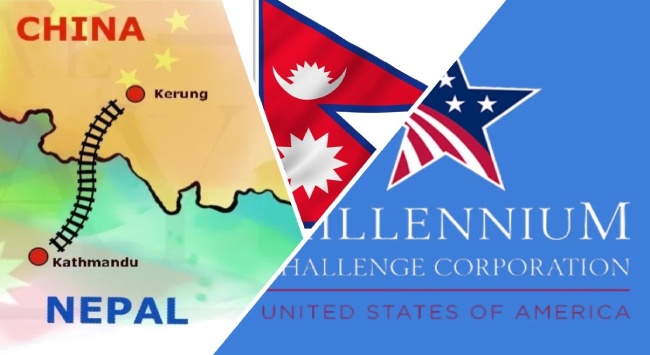Summary
The decision by American President Donald Trump’s administration to cut funding for projects in Nepal may affect ties between the two countries. On the other hand, after more than seven years of its signing, Nepal and China have agreed on the cooperation framework for the projects under the Belt and Road Initiative. A change in Nepal’s political equation with the United States and China may have a geopolitical consequence for the South Asian region.
Following President Donald Trump’s assumption of office in January 2025, his administration decided to cut funding for United States (US) assistance bodies, affecting their projects in partnership with the government. A new executive order on reforming the federal bureaucracy reiterated that “President Trump temporarily paused foreign aid to many non-governmental organizations, international organizations, and contractors to ensure every dollar of US foreign assistance supports American values.” Like many other funding bodies, the activities of the Millennium Challenge Corporation (MCC) across the world and in Nepal have been affected due to this order. Communicating its position, in an email dated 14 February 2025, the MCC informed Nepal that payments related to the projects funded under the MCC Nepal Compact have been halted in compliance with the 90-day freeze imposed by the Trump administration in January this year. The US government has also cancelled US$39 million (S$52 million) in aid allocated to Nepal’s federalism and biodiversity projects.
The MCC was created by the US Congress in 2004. It partners with least developed countries, providing them with time-limited grants to promote economic growth to reduce and strengthen institutions. There are three primary types of MCC grants:
- Compacts – five-year grants for the countries that meet the MCC’s eligibility.
- Concurrent Compacts for Regional Investments – grants that promote cross-border economic integration and increase regional trade and collaboration.
- Threshold Programs – smaller grants with a focus on policy and institutional reform in selected countries that come close to passing the MCC’s eligibility criteria and show commitment to improving policy performance.
In September 2017, Kathmandu signed the MCC Nepal Compact programme. There were significant political debate in Nepal on the MCC being an American tool to counter China’s Belt and Road Initiative (BRI). It took the country five years to ratify the MCC, and it did so with 12 interpretative declarations. One of the main points of political contention was the MCC was part of Washington’s larger Indo-Pacific strategy to counter China. Only after clarification from the MCC’s headquarters that it has no link with the US’ Indo-Pacific strategy, Nepal agreed to its ratification. Also, during her visit to Kathmandu, then MCC’s Vice President Fatema Z Sumar stated that the organisation has no military component and its implementation does not undermine Nepal’s sovereignty.
The MCC Nepal Compact projects, including the construction of a 315-kilometre, 400 kilovolt transmission line and road infrastructure upgrades, received US$500 million (S$670 million) in funding from the MCC, while the Nepal government committed an additional US$197 (S$265 million). The MCC Nepal Compact came into effect on 30 August 2023.
Following the freezing of funds by the Trump administration, Nepal is faced with a dilemma: Who will fill the void should the Trump administration decides to cancel or cut the funding for the projects under the MCC Nepal Compact? There are discussions within Nepal’s political circle on the possibility of seeking aid from countries such as the United Kingdom, Germany, South Korea and Japan should the US’ funding not continue. India and China are also possible options.
Unlike the MCC, there is progress between Nepal and China on the BRI. After a memorandum of understanding on the BRI was signed in May 2017, the programme hit a roadblock. One of the hurdles was the failure by both sides to reach a consensus on the nature of the financing. The Nepali side proposed a “grant financing cooperation modality”, which was amended by the Chinese to an “assistant financing modality”. Finally, after talks, the term “aid assistance financing” was agreed upon by both countries.
During the visit of Nepal’s Prime Minister K P Sharma Oli to China in December 2024, the two countries signed the BRI Cooperation Framework. The joint statement issued during Oli’s visit stated that the two sides “expressed their commitment to strengthening connectivity between the two countries in such areas as ports, roads, railways, aviation, power grids and telecommunication to help Nepal transform from a land-locked country to a land-linked country”. They agreed on several initiatives such as jointly advancing the fourth phase of the China-aided Araniko Highway maintenance project and the Hilsa-Simikot Road project; implementing the second phase of the Kathmandu Ring Road Improvement Project and promoting the repair of the Syaphrubesi-Rasuwagadhi Highway, among others.
Aid, grants and investments are generally political in nature. US Secretary of State Marco Rubio vindicated American politics of aids when he said “Every dollar we spend, every program we fund, and every policy we pursue must be justified with the answer to three simple questions: Does it make America safer? Does it make America stronger? Does it make America more prosperous?” The MCC may not have any strategic intention, but it certainly helps the US broaden its socio-political and economic influence in Nepal. Therefore, cancelling or cutting this funding will affect ties between the two countries while the recent agreement on the BRI projects will create more space for China in Nepal. Any such change in the situation may have a far-reaching geopolitical consequence for the South Asian region.
. . . . .
Dr Amit Ranjan is a Research Fellow at the Institute of South Asian Studies (ISAS), an autonomous research institute at the National University of Singapore (NUS). He can be contacted at isasar@nus.edu.sg. The author bears full responsibility for the facts cited and opinions expressed in this paper.
Pic Image: ISAS-NUS and Wikimedia Commons
-
 More From :
More From :
-
 Tags :
Tags :
-
 Download PDF
Download PDF


